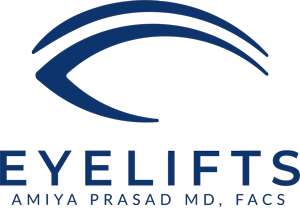What is Ptosis?
Simply put, ptosis refers to drooping eyelids caused by weak muscle tone or nerve damage. In adults, the most common type of ptosis is called “involutional ptosis.” This condition occurs when the levator muscle, which is responsible for lifting the eyelids, simply stretches and thins instead of lifting the eyelid upwards.
Many people with this condition are frustrated by the strain of keeping their eyes open particularly when reading, and often complain of headaches because of having to resort to lifting their eyebrows in order to get some lift out of their eyelids. Changing eyeglasses and even undergoing other surgical procedures like cataract surgery does not solve the problem.
Ptosis Surgery
In adults, drooping eyelids (ptosis) occur slowly over time and can impair vision. However, a simple eyelid ptosis surgery, which takes less than an hour to perform, can allow patients to see better and even look better. Ptosis surgery may be necessary when the ptosis has caused the eyelid to partially or completely block vision. Eyelid ptosis in children often requires aggressive management in order to allow vision to develop normally.
It must be noted that not all cases of ptosis may require surgery right away. Oftentimes, the cause of ptosis is not just a weakened levator muscle in the eye, but rather something else entirely. For example, the drooping of the upper eyelid is often a precursor to myasthenia gravis, in which case, a neurologist must be consulted. It is therefore extremely important to have a proper screening in order to determine if the case is simply ptosis, or if it is ptosis triggered by a more serious condition.
Before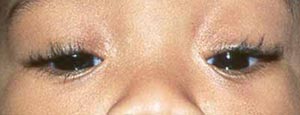 |
After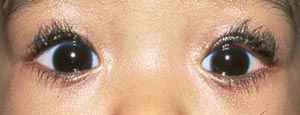 |
This 10-month old baby was born with the inability to open his eyes due to a condition called Congenital Ptosis. Due to his inability to open his eyes, he was at risk of developing permanent vision loss called amblyopia. Dr. Prasad performed bilateral ptosis surgery with frontalis sling using fascia lata. The patient is now 14 years old and continues to have good vision and open eyes.
Before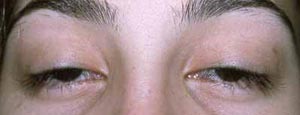 |
After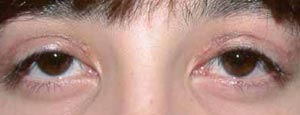 |
This 12-year old female had congenital ptosis, which caused her eyelids to droop due to the poor development of the muscle that lifts her eyelid called the levator muscle. She had difficulty doing her school work and was unable to keep her eyes open by the end of the day. Dr. Prasad performed bilateral ptosis surgery frontalis sling with fascia lata. She is able to now comfortably open her eyes and continue her education.
Before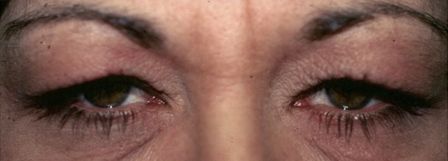 |
After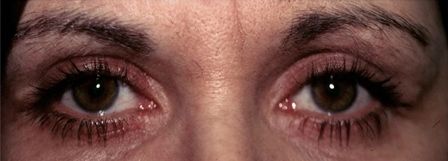 |
This 43-year old woman had a long history of smoking and sun exposure, which were likely contributors to her developing significant amounts of excess skin over her eyes. The excess skin over her eyes caused her eyelids to droop (mechanical ptosis). She underwent bilateral upper eyelid blepharoplasty to reduce mechanical ptosis, resulting in an improved appearance and better vision.
What Kind of Doctor Does Ptosis Surgery?
Ptosis surgery is a highly specialized surgery done by oculofacial/oculoplastic surgeons. Ptosis correction surgery is not performed by cosmetic surgeons who routinely do cosmetic eyelid surgery (blepharoplasty). In fact, ptosis can be misdiagnosed by a cosmetic surgeon to be extra or loose skin over the eyes, leaving the upper eyelids still drooping after eyelid surgery, but with less eyelid skin as a result.
Since ptosis correction is a high-precision surgery operating on the often unpredictable levator muscle, it does have a higher incidence of surgical enhancements needed across oculoplastic surgeons. To see the results of surgery under day-to-day conditions and normal gravity, Dr. Prasad has his patients sit up during surgery to make sure the eyelid height is correct with the aid of a raised surgical bed. This has enabled Dr. Prasad to perform ptosis surgery only once close to 100% of the time.

Dr. Prasad sits patients up toward the end of ptosis correction surgery to see assess if eyelid height is correct when upright and under normal gravity.
Before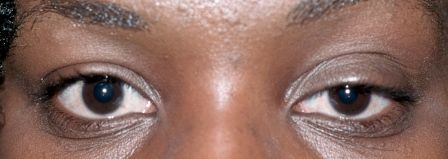 |
After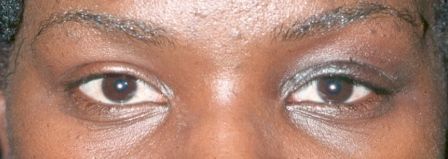 |
This 28-year old African-American female has been aware of her left eye drooping since she was born. She noticed that as she got older, the drooping of the eyelids became more noticeable and made it more difficult for her to see. She was very concerned about the cosmetic result and underwent corrective ptosis surgery of the left upper eyelid under local anesthesia. She is very happy with her ability to see better and the symmetry of her eyes.
Before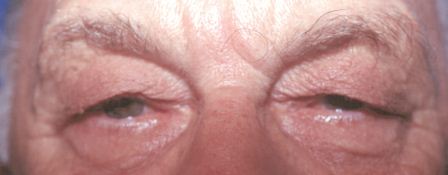 |
After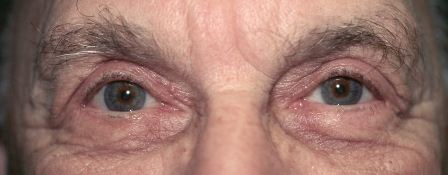 |
This 76-year old man had been seeing eye doctors and complaining of difficulty seeing. He was told that his eye exams were essentially normal. He noticed that when he lifted up his eyelids with his fingers that his vision improved. He realized that his upper eyelids were acting like window shades and blocking his sight. After seeing Dr. Prasad he was diagnosed with age related (involutional) ptosis, which is due to a progressive thinning and stretching of the muscle that lifts the eyelid called the levator muscle, specifically the levator aponeurosis. He underwent bilateral upper eyelid blepharoplasty and repair of involutional ptosis resulting in a significant improvement in his vision.
Before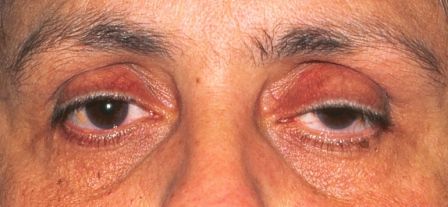 |
After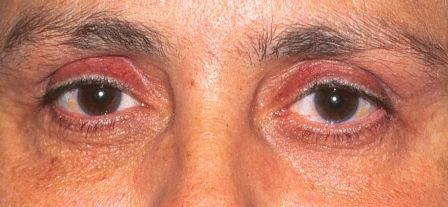 |
This 43-year old female suffered from Lupus and had severe dry eye syndrome. She noticed that over several years her eyelids were drooping to the point that she could not see. When she was examined, it appeared that the muscle that lifts her eyelid had thinned and stretched, resulting in her eyelids drooping. She underwent bilateral levator muscle advancement. Once the levator muscles were repaired she noticed a significant improvement in her vision and was able to manage her dry eye adequately to further enhance her vision.
Ptosis Caused by a Prosthetic Eye
Prosthetic eye pieces can escalate stretching of the delicate levator muscle that lifts the eyelid. The hard prosthetic eye, along with a less lubricated surface than a natural eye, stretches the levator muscle prematurely. In such cases, the drooping eyelid is corrected, with the addition of lubricating drops to help prevent future stretching of the levator muscle.
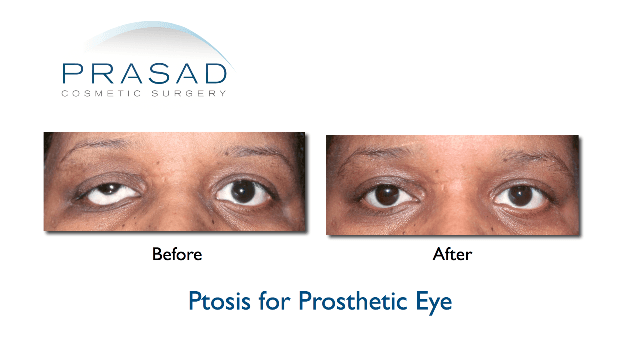
Eyelids rubbing against the hard, dry surface of a prosthetic eye causes premature stretching and weakening of the muscle that lifts the eyelid.
Ptosis May Require More than One Surgery
People born with ptosis, which is referred to as congenital ptosis, should expect more than one congenital ptosis treatment in their lifetime. This usually involves the initial surgery in childhood for proper visual development, another around the time of the adolescent years for aesthetic reasons to bring more symmetry to the upper eyelids, and another later in life due to the stretching of levator muscle due to normal aging.
As an Oculoplastic surgeon, Dr. Amiya Prasad is an expert in eye and cosmetic eye surgery. Eyelid ptosis surgery is one of the many cosmetic eye surgeries he offers that can help you regain better vision and give you the youthful-looking face you want.
Take a moment to peruse our website and find out why so many people are turning to Dr. Prasad for eyelid ptosis surgery procedures. For more information about our services and our luxurious, state-of-the-art facilities, visit our eyelift surgery FAQ section, or feel free to contact us. We would be happy to answer any questions you may have.
Before making a decision, please consider having a personal evaluation with ptosis surgery NYC specialist and Oculofacial plastic surgeon Dr. Amiya Prasad to determine what is the most appropriate procedure(s) for your specific case.
